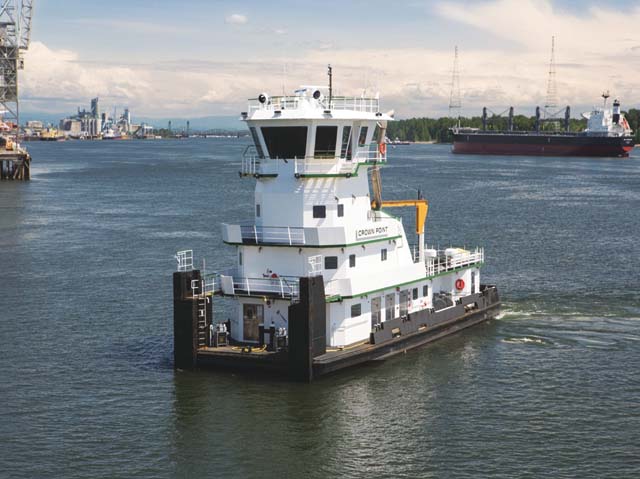Tidewater Barge Lines' towboat Crown Point is the first U.S. West Coast vessel to pass Subchapter M scrutiny, after the Coast Guard marine safety unit in Portland, Ore., recently issued a certification of inspection (COI).
COI requirements are taking effect under the Subchapter M towing vessel regulations, requiring operators to certify they are met through inspections in-house, by approved third-party surveyors, or Coast Guard inspection.
The 102’x38’, 4,480-hp Crown Point was delivered in 2015 by Vigor Industrial, Portland, Ore. It was the first of three towboats to be built for Tidewater, based in Vancouver, Wash. It serves on the 1,243-mile Columbia-Snake River System, moving barges between Lewiston, Idaho, and Vancouver.
Coast Guard officials noted there are 130 towing vessels currently operating on the Columbia-Snake River System and over 5,000 U.S. flagged towing vessels subject to inspection under Subchapter M. In April, the first vessel to obtain a COI was the Endeavor, an 86.7’x50’x10.8’, 4,200-hp ship docking module (SDM) tractor tug operated by Marine Towing of Tampa, Tampa, Fla.
All towing vessels are required to comply with Subchapter M rules by July 20, 2018, and the COI provisions are being phased in. Towing companies have options under Subchapter M, such as using Coast Guard-approved third party inspections and an internal Towing Safety Management System (TSMS) to ensure their vessels are in compliance. Policy memoranda from the Coast Guard specify how the COI process is working in those circumstances, and the use of uninspected towing vessel (UTV) examination stickers as proof of earlier compliance.
“The Columbia and Snake River Systems move $24 billion of cargo on an annual basis, and the towing vessels that fall under the regulations listed under Subchapter M are an integral part of this economically valuable marine transportation system,” said Capt. Tom Griffitts, the commanding officer MSU Portland in announcing the certificate. “The Subchapter M regulations will provide safer vessel movement, safer working conditions for crewmembers, reduce marine casualties, and will help avoid environmental and property damage.”
The Subchapter M regulations provide minimum safety, lifesaving, construction, machinery, electrical, and operational requirements for U.S. towing vessels. All applicable towing vessels must be in compliance with the Subchapter M regulations by July 20, 2018. The initial inspection activities and issuance of COIs will be phased-in over a four year period.
Towing vessel owners and operators are encouraged to contact their local Coast Guard Inspection office to coordinate and schedule Subchapter M inspections. Additional Subchapter M regulation information and compliance resources can be found on the Towing Vessel National Center of Expertise’s website www.dco.uscg.mil/tvncoe.




